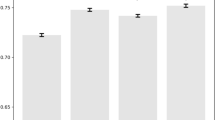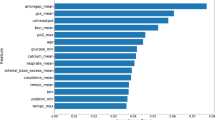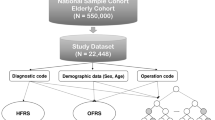Abstract
Machine learning (ML) techniques may improve readmission prediction performance in heart failure (HF) patients. This study aimed to assess the ability of ML algorithms to predict unplanned all-cause 30-day readmissions in HF elderly patients, and to compare them with conventional LACE (Length of hospitalization, Acuity, Comorbidities, Emergency department visits) index. All patients aged ≥ 65 years discharged alive between 2010 and 2019 after a hospitalization for acute HF were included in this retrospective cohort study. We applied MICE (Multivariate Imputation via Chained Equations) method to obtain a balanced, fully valued dataset and LASSO (Least Absolute Shrinkage and Selection Operator) algorithm to get the most significant features. Training (80% of records) and test (20%) cohorts were randomly selected. Study population: 3079 patients, 394 (12.8%) presented at least one readmission within 30 days, and 2685 (87.2%) did not. In the test cohort AUCs (IC95%) of XGBoost, Ada Boost Classifier, Random forest, and Gradient Boosting, and LACE Index were: 0.803 (0.734–0.872), 0.782 (0.711–0.854), 0.776 (0.703–0.848), 0.786 (0.715–0.857), and 0.504 (0.414–0.594), respectively, for predicting readmissions. A SHAP analysis was performed to offer a breakdown of the ML variables associated with readmission. Positive and negative predicting values estimates of the different ML models and LACE index were also provided, for several values of readmission rate prevalence. Among elderly patients, the rate of all-cause unplanned 30-day readmissions after hospitalization due to an acute HF was high. ML models performed better than the conventional LACE index for predicting readmissions. ML models can be proposed as promising tools for the identification of subjects at high risk of hospitalization in this clinical setting, enabling care teams to target interventions for improving overall clinical outcomes.




Similar content being viewed by others
References
Correale M, Paolillo S, Ruocco G, Palazzuoli A, Nodari S; from Italian Society of Cardiology (SIC) Working Group on Heart Failure: Comprehensive heart failure assessment: a challenge to modify the course of heart failure. Author's reply. Eur J Intern Med. 74:125-126. https://doi.org/10.1016/j.ejim.2020.01.020. Epub 2020 Feb 9. PMID: 32046942
Ponikowski P, Voors AA, Anker SD, Bueno H, Cleland JGF, Coats AJS et al (2016) ESC guidelines for the diagnosis and treatment of acute and chronic heart failure. Eur Heart J 2015:ehw128
Bergethon K, Ju C, De Vore A, Hardy NC, Fonarow GC, Yancy CW, Heidenreich PA, Bhatt DL, Peterson ED, Hernandez AF (2016) Trends in 30-day readmission rates for patients hospitalized with heart failure. Circulation. 9:e002594. https://doi.org/10.1161/CIRCHEARTFAILURE.115.002594 (originally published June 14, 2016)
Ponikowski P, Anker SD, AlHabib KF, Cowie MR, Force TL, Hu S et al (2014) Heart failure: preventing disease and death worldwide. ESC Hear Fail 1:4–25
Ambrosy AP, Fonarow GC, Butler J, Chioncel O, Greene SJ, Vaduganathan M et al (2014) The global health and economic burden of hospitalizations for heart failure: lessons learned from hospitalized heart failure registries. J Am Coll Cardiol Elsevier Inc 63:1123–1133. https://doi.org/10.1016/j.jacc.2013.11.053
Ricciardi E, La Malfa G, Guglielmi G et al (2020) Characteristics of current heart failure patients admitted to internal medicine vs. cardiology hospital units: the VASCO study. Intern Emerg Med 15:1219–1229. https://doi.org/10.1007/s11739-020-02304-4
Belfiore A, Palmieri VO, Di Gennaro C et al (2020) Long-term management of chronic heart failure patients in internal medicine. Intern Emerg Med 15:49–58. https://doi.org/10.1007/s11739-019-02024-4
Piñeiro-Fernández J, Fernández-Rial Á, Suárez-Gil R et al (2021) Evaluation of a patient-centered integrated care program for individuals with frequent hospital readmissions and multimorbidity. Intern Emerg Med. https://doi.org/10.1007/s11739-021-02876-9
Senni M, Parrella P, De Maria R, Cottini C, Bohm M, Ponikowski P, Filippatos G, Tribouilloy C, Di Lenarda A, Oliva F, Pulignano G, Cicoira M, Nodari S, Porcu M, Cioffi G, Gabrielli D, Parodi O, Ferrazzi P, Gavazzi A (2011) Predicting heart failure outcome from cardiac and comorbid conditions: the 3C-HF score. Int J Cardiol. https://doi.org/10.1016/j.ijcard.2011.10.071
Averbuch T, Lee SF, Mamas MA, Oz UE, Perez R, Connolly SJ, Ko DT, Van Spall HGC (2021) Derivation and validation of a two-variable index to predict 30-day outcomes following heart failure hospitalization. ESC Heart Fail. https://doi.org/10.1002/ehf2.13324 (Epub ahead of print. PMID: 33932113)
Van Walraven C, Dhalla IA, Bell Ch, Etchells E, Stiell IG (2010) Derivation and validation of an index to predict early death or unplanned readmission after discharge from hospital to the community. CMAJ 6:51–557
Kansagara D, Englander H, Salanitro A, Kagen D, Theobald C et al (2011) Risk prediction models for hospital readmission: a systematic review. JAMA 306(15):1688–1698
Pocock SJ, Ariti CA, McMurray JJV, Maggioni A, Køber L, Squire IB et al (2013) Predicting survival in heart failure: a risk score based on 39 372 patients from 30 studies. Eur Heart J 34:1404–1413. https://doi.org/10.1093/eurheartj/ehs337 (PMID: 23095984)
Van Calster B, Verbakel JY, Christodoulou E, Steyerberg EW, Collins GS (2019) Statistics versus machine learning: definitions are interesting (but understanding, methodology, and reporting are more important). J Clin Epidemiol 116:137–138. https://doi.org/10.1016/j.jclinepi.2019.08.002 (Epub 2019 Aug 16 PMID: 31425736)
Zhang Z, Zhang H, Khanal MK (2017) Development of scoring system for risk stratification in clinical medicine: a step-by-step tutorial. Ann Transl Med 5(21):436. https://doi.org/10.21037/atm.2017.08.22.PMID:29201888;PMCID:PMC5690964
Sun GW, Shook TL, Kay GL (1996) Inappropriate use of bivariable analysis to screen risk factors for use in multivariable analysis. J Clin Epidemiol 49(8):907–916. https://doi.org/10.1016/0895-4356(96)00025-x (PMID: 8699212)
Bagley SC, White H, Golomb BA (2001) Logistic regression in the medical literature: standards for use and reporting, with particular attention to one medical domain. J Clin Epidemiol 54:979–985 (PMID: 11576808)
Levy WC, Anand IS (2014) Heart failure risk prediction models: what have we learned? JACC Heart Fail 2:437–439 ([PubMed: 25194289])
Grant L, Joo P, Nemnom MJ et al (2021) Machine learning versus traditional methods for the development of risk stratification scores: a case study using original Canadian Syncope Risk Score data. Intern Emerg Med. https://doi.org/10.1007/s11739-021-02873-y
Christodoulou E, Ma J, Collins GS, Steyerberg EW, Verbakel JY, Van Calster B (2019) A systematic review shows no performance benefit of machine learning over logistic regression for clinical prediction models. J Clin Epidemiol 110:12–22. https://doi.org/10.1016/j.jclinepi.2019.02.004 (Epub 2019 Feb 11 PMID: 30763612)
Eapen ZJ, Liang L, Fonarow GC, Heidenreich PA, Curtis LH, Peterson ED, Hernandez AF (2013) Validated, electronic health record deployable prediction models for assessing patient risk of 30-day rehospitalization and mortality in older heart failure patients. JACC Heart Fail 1:245–251. https://doi.org/10.1016/j.jchf.2013.01.008
Dedalus spa. Tabula Clinica. http://www.dedalus.eu (Accessed December 2019).
van Buuren S, Boshuizen HC, Knook DL (1999) Multiple imputation of missing blood pressure covariates in survival analysis. Stat Med 18:681–694
Tibshirani R (1996) Regression Shrinkage and Selection via the lasso. J R Stat Soc Ser B (Methodol) Wiley 58 (1): 267–88 (JSTOR 2346178)
Gruneir A, Dhalla IA, van Walraven C, Fischer HD, Camacho X, Rochon PA, Anderson GM (2011) Unplanned readmissions after hospital discharge among patients identified as being at high risk for readmission using a validated predictive algorithm. Open Med 5(2):e104–e111 (Epub 2011 May 31)
Adadi A, Berrada M (2018) Peeking inside the black-box: a survey on explainable artificial intelligence (XAI). IEEE Access 6:52138–52160
Lundberg SM, Lee S-I (2017) A unified approach to interpreting model predictions. Adv Neural Inf Process Syst 30:4765–4774
Hayden SR, Brown MD (1999) Likelihood ratio: a powerful tool for incorporating the results of a diagnostic test into clinical decisionmaking. Ann Emerg Med 33(5):575–580. https://doi.org/10.1016/s0196-0644(99)70346-x (PMID: 10216335)
Andrès E, Talha S, Hajjam M, Hajjam J, Ervé S, Hajjam A (2018) Experimentation of 2.0 telemedicine in elderly patients with chronic heart failure: a study prospective in 175 patients. Eur J Intern Med. 51:e11–e12. https://doi.org/10.1016/j.ejim.2018.02.022 (Epub 2018 Mar 7. PMID: 29525507)
Golas SB, Shibahara T, Agboola S, Otaki H, Sato J, Nakae T, Hisamitsu T, Kojima G, Felsted J, Kakarmath S, Kvedar J, Jethwani K (2018) A machine learning model to predict the risk of 30-day readmissions in patients with heart failure: a retrospective analysis of electronic medical records data. BMC Med Inform Decis Mak 18(1):44. https://doi.org/10.1186/s12911-018-0620-z
Mahajan SM, Mahajan AS, King R, Negahban S (2018) Predicting risk of 30-day readmissions using two emerging machine learning methods. Stud Health Technol Inform 250:250–255
Mortazavi BJ, Downing NS, Bucholz EM et al (2016) Analysis of machine learning techniques for heart failure readmissions. Circ Cardiovasc Qual Outcomes 9:629–640
Wang H, Robinson RD, Johnson C, Zenarosa NR, Jayswal RD, Keithley J, Delaney KA (2014) Using the LACE index to predict hospital readmissions in congestive heart failure patients. BMC Cardiovasc Disord 14:97. https://doi.org/10.1186/1471-2261-14-97
Wongvibulsin S, Wu KC, Zeger SL (2020) Improving clinical translation of machine learning approaches through clinician-tailored visual displays of black box algorithms: development and validation. JMIR Med Inform 8(6):e15791. https://doi.org/10.2196/15791.PMID:32515746;PMCID:PMC7312245
Kajimoto K, Sato N, Keida T, Sakata Y, Asai K, Mizuno M, Takano T, Investigators of the Acute Decompensated Heart Failure Syndromes (ATTEND) registry (2014) Low admission heart rate is a marker rather than a mediator of increased in-hospital mortality for patients with acute heart failure syndromes in sinus rhythm. Int J Cardiol. 171(1):98–100. https://doi.org/10.1016/j.ijcard.2013.11.087 (Epub 2013 Dec 4. PMID: 24342405)
Author information
Authors and Affiliations
Contributions
HPF: Conceptualization, methodology, formal analysis, investigation, data curation, writing review and editing, supervision, project administration. VE: Conceptualization, ML models development, data curation, writing review and editing. GM: Methodology, formal statistical analysis, data curation, writing review and editing. LP: Investigation, data curation, interpretation of results, writing review and editing. AV: ML models development, data curation, writing review and editing. GD: Conceptualization, investigation, interpretation of results, writing review and editing. MB: Conceptualization, investigation, interpretation of results, writing review and editing. GG: Conceptualization, methodology, interpretation of results, writing review and editing. GM: Conceptualization, methodology, interpretation of results, writing review and editing. PB: Conceptualization, methodology, formal statistical analysis, data curation, writing review and editing, supervision.
Corresponding author
Ethics declarations
Conflict of interest
The author(s) declare that they have no conflict of interest.
Human and animal rights statement and Informed consent
Ethical approval was required to the Institutional Research Ethics Committee (Comitato Etico Brianza), and informed consent was waived given the retrospective non-interventional, observational design.
Writing assistance
None to declare. This research did not receive any specific grant from funding agencies in the public, commercial, or not-for-profit sectors. The work has not been published previously and it is not under consideration for publication elsewhere.
Authorship
Authors declare that all have made substantial contributions to the conceptualization and design of the work, the acquisition, analysis, and the interpretation of data. All authors revised critically the draft adding important intellectual content. All authors approve the final version to be published.
Additional information
Publisher's Note
Springer Nature remains neutral with regard to jurisdictional claims in published maps and institutional affiliations.
Rights and permissions
About this article
Cite this article
Polo Friz, H., Esposito, V., Marano, G. et al. Machine learning and LACE index for predicting 30-day readmissions after heart failure hospitalization in elderly patients. Intern Emerg Med 17, 1727–1737 (2022). https://doi.org/10.1007/s11739-022-02996-w
Received:
Accepted:
Published:
Issue Date:
DOI: https://doi.org/10.1007/s11739-022-02996-w




